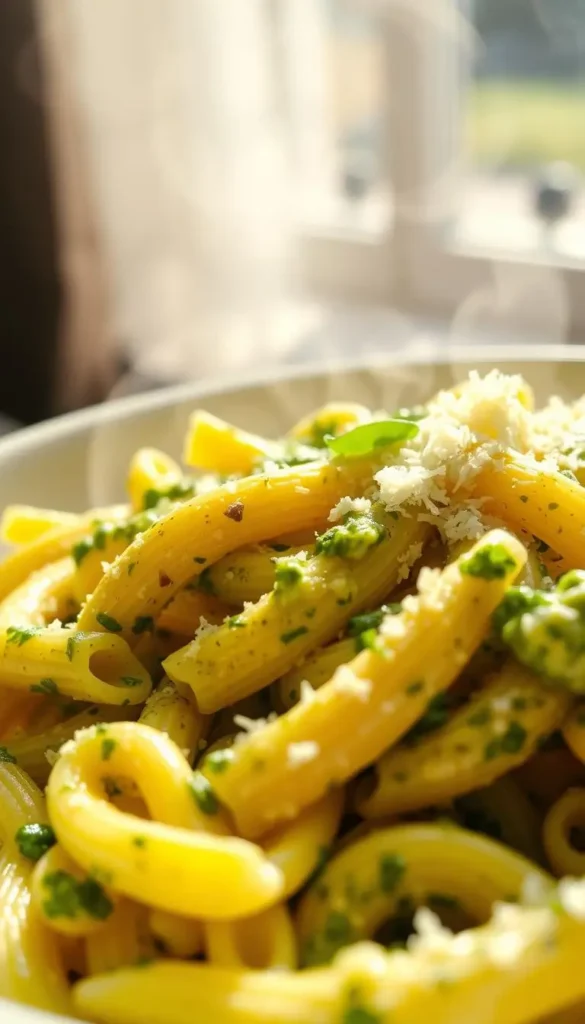I remember my first taste of Pesto Pasta at an Italian restaurant. The burst of fresh basil and creamy texture was unforgettable. It made me want to make it at home.
Making Pesto Pasta is easy, needing just a few ingredients. The secret is using top-notch basil and olive oil for that real Italian taste.
I’m thrilled to share this recipe with you. You’ll love the creamy, rich flavor of homemade Pesto Pasta. It’s great for a quick dinner or a special event.
Key Takeaways
- Simple ingredients are all you need to make delicious Pesto Pasta.
- High-quality basil and olive oil are key for the authentic Italian flavor.
- This recipe is perfect for both weeknight dinners and special occasions.
- Pesto Pasta is a versatile dish that can be customized to your taste.
- Homemade Pesto Pasta offers a richer flavor compared to store-bought versions.
The Magic of Homemade Pesto Pasta
Homemade pesto pasta is more than just a meal; it’s an experience. When you make it from scratch, you can customize the ingredients to suit your taste. This ensures a fresher flavor that store-bought versions can’t match.

Why This Recipe Stands Out
This recipe stands out because it allows for flexibility and creativity. You can adjust the amount of garlic, the type of cheese, and even add other ingredients like sun-dried tomatoes or grilled chicken to make it your own.
What Makes Pesto Pasta So Beloved
Pesto pasta is beloved for its rich flavor profile and versatility. The combination of basil, garlic, pine nuts, and Parmesan cheese creates a sauce that’s both creamy and aromatic. It’s a dish that can be enjoyed as a quick weeknight dinner or as a centerpiece for a dinner party.
The beauty of homemade pesto pasta lies in its ability to be tailored to individual tastes. This makes it a favorite among many.
History and Origins of Pesto
The story of pesto is quite interesting. It comes from the Liguria region in Italy. This sauce is a big part of traditional Italian cooking.
Traditional Genovese Pesto
Traditional Genovese pesto, or Pesto alla Genovese, uses simple ingredients. You need fresh basil, garlic, pine nuts, Parmesan cheese, and olive oil. The word “pesto” means to pound or crush. This is how the sauce was made long ago with a mortar and pestle.

Evolution of Modern Pesto Recipes
Pesto has changed over time. New recipes add different ingredients but keep the traditional taste. You might find spinach, walnuts, or sun-dried tomatoes in modern pesto. These changes give the classic sauce a fresh spin.
| Ingredient | Traditional Use | Modern Variations |
|---|---|---|
| Basil | Fresh basil leaves | Spinach or kale |
| Nuts | Pine nuts | Walnuts or almonds |
| Cheese | Parmesan | Pecorino or vegan alternatives |
The story of pesto shows how cooking traditions grow. They adapt to new tastes but always remember the old ways.
Health Benefits of Basil and Pine Nuts
Pesto pasta’s key ingredients, basil and pine nuts, offer numerous health benefits. Adding these to your diet can boost your overall health.
Nutritional Profile of Fresh Basil
Fresh basil is packed with vitamins A, C, and K. It’s also a good source of minerals like potassium and magnesium. These nutrients support heart health and provide antioxidant benefits. Basil also has anti-inflammatory properties. These can help lower the risk of chronic diseases.
Health Properties of Pine Nuts
Pine nuts are full of healthy fats, protein, and fiber. They also have vitamins and minerals that are vital for our bodies.
Vitamins and Minerals
Pine nuts are rich in vitamin E, magnesium, and zinc. These nutrients are key for healthy skin, hair, and eyes.
Healthy Fats
Pine nuts have monounsaturated and polyunsaturated fats. These fats can lower cholesterol levels and reduce heart disease risk.
Knowing the nutritional benefits of basil and pine nuts shows why pesto pasta is a healthy meal choice.
Essential Equipment for Perfect Pesto
Making perfect pesto pasta needs the right tools. I’ll guide you through the essentials. You’ll focus on two main areas: making the pesto sauce and cooking the pasta.
Food Processors vs. Mortar and Pestle
The debate between food processors and mortar and pestle for pesto is ongoing. Food processors are quick and efficient, blending ingredients fast. A mortar and pestle offers a traditional, tactile experience, releasing flavors and oils from basil leaves well. Both methods work great, but it’s up to you and your pesto texture preference.
Pasta Cooking Tools
Cooking pasta to the perfect al dente texture needs the right tools. A large pot is key for boiling pasta. A colander is needed for draining. Also, a pasta timer ensures your pasta is cooked just right. With these tools, you’ll make a delicious pesto pasta dish.
📝 Ingredients
To make delicious Pesto Pasta, start by gathering the right ingredients. You’ll need two main parts: the Pesto Sauce and the Pasta Dish.
For the Pesto Sauce
Fresh Herbs and Nuts
The Pesto Sauce needs fresh basil leaves, pine nuts (or walnuts), and garlic cloves. Freshness is key, so choose the best quality you can find.
Oils and Cheeses
You’ll also need good quality olive oil and grated Parmesan cheese. The olive oil blends the sauce smoothly. The Parmesan adds a rich, savory flavor.
For the Pasta Dish
Pasta Selection
Choose a pasta shape that holds onto the sauce well, like linguine or spaghetti. High-quality pasta is important for the dish.
Additional Components
Adding cherry tomatoes, grilled chicken, or shrimp can enhance your Pesto Pasta. These ingredients add protein and extra flavor.
| Ingredient | Quantity | Purpose |
|---|---|---|
| Fresh Basil Leaves | 2 cups | Pesto Sauce |
| Pine Nuts | 1/2 cup | Pesto Sauce |
| Parmesan Cheese | 1 cup grated | Pesto Sauce |
| Linguine or Spaghetti | 8 oz | Pasta Dish |
| Olive Oil | 1/2 cup | Pesto Sauce |
Selecting the Best Ingredients for Pesto Pasta
To make a top-notch pesto pasta, picking the right ingredients is key. The quality of basil, pasta type, and cheese all matter a lot. They all help shape the dish’s taste.
Choosing Quality Basil
Fresh, vibrant basil is the heart of a great pesto sauce. When choosing basil for pesto, look for leaves that are bright green and without blemishes. Stay away from wilted or brown leaves, as they can make the sauce bitter. Genovese basil is a favorite because of its sweet and slightly spicy taste.
Finding the Right Pasta Shape
The pasta shape affects how well the pesto sauce sticks to it. Selecting the right pasta shape is key for a balanced dish. Traditionally, linguine or spaghetti are top picks. But, shapes like fusilli or farfalle also work well because their twists and irregular shapes hold onto the sauce.
| Pasta Shape | Suitability for Pesto | Reason |
|---|---|---|
| Linguine | High | Long, flat shape holds sauce well |
| Fusilli | High | Twisted shape traps sauce |
| Spaghetti | Medium | Long, thin shape; sauce clings but can be slippery |
Cheese Selection Tips
The cheese in pesto pasta greatly affects its taste. Parmesan is a classic pick, but there are other options.
Parmesan Alternatives
For a different taste, try Grana Padano or Pecorino Romano. Grana Padano is milder, while Pecorino Romano is salty and tangy.
Pecorino Romano Options
Pecorino Romano is a sharp, salty cheese that goes well with basil. Use it sparingly because it’s strong. Mixing it with Parmesan can balance the flavors.
👩🍳 Instructions
Now that we have our ingredients ready, let’s dive into making delicious Pesto Pasta. We’ll make the perfect pesto, cook the pasta just right, and mix them together.
Making the Perfect Pesto
To make the pesto, we start with fresh ingredients. Preparing the basil is the first step.
Preparing the Basil
Rinse the basil leaves gently and pat them dry with a paper towel. Remove the leaves from the stem, and you’re ready to blend.
Toasting the Pine Nuts
Place the pine nuts on a baking sheet and toast them in the oven at 350°F (175°C) for about 5 minutes. They should be fragrant and lightly browned. Keep an eye on them to prevent burning.
Cooking the Pasta
Cooking the pasta al dente is key for a great Pesto Pasta dish.
Achieving Al Dente Texture
Bring a large pot of salted water to a boil. Cook the pasta according to the package instructions until it’s al dente. This usually takes around 8-10 minutes, depending on the pasta shape.
Reserving Pasta Water
Before draining the pasta, reserve about a cup of pasta water. This water can be used later to adjust the consistency of the pesto sauce.
Combining Pasta and Sauce
Now it’s time to bring everything together.
Proper Mixing Techniques
In a large mixing bowl, combine the cooked pasta, pesto sauce, and some reserved pasta water. Toss everything together until the pasta is well coated.
Final Adjustments
Taste the pasta and adjust the seasoning as needed. You can add more pesto, salt, or pasta water to achieve the desired flavor and consistency.
| Step | Action | Notes |
|---|---|---|
| 1 | Prepare Basil | Rinse and dry basil leaves |
| 2 | Toast Pine Nuts | 350°F (175°C) for 5 minutes |
| 3 | Cook Pasta | Al dente, reserve pasta water |
| 4 | Combine Pasta and Pesto | Toss with reserved pasta water |
Common Mistakes to Avoid When Making Pesto Pasta
Even the most skilled cooks can make mistakes when making pesto pasta. Knowing these common errors can make a big difference. It’s important to get the sauce right, cook the pasta correctly, and serve it well.
Sauce Consistency Issues
Getting the sauce consistency wrong is a common mistake. If it’s too thick, it can be too strong. If it’s too thin, it won’t stick to the pasta. To fix this, add olive oil slowly while blending until it’s just right.
Pasta Cooking Errors
Overcooking or undercooking the pasta can mess up the dish. Always follow the package instructions for cooking time. Drain the pasta right away to stop it from cooking more.
Serving Temperature Problems
Serving pesto pasta at the wrong temperature can change its taste and feel. Pasta should be served hot, and the pesto sauce should be at room temperature. This way, the flavors will mix well together.
By avoiding these mistakes, you can make your pesto pasta better. Enjoy a more delicious meal.
Delicious Variations of Pesto Pasta
Pesto pasta comes in many forms, from classic to new. Its flexibility is why it’s so popular. By changing a few ingredients, you can make a dish that’s both new and exciting.
Sun-Dried Tomato Pesto Pasta
Adding sun-dried tomatoes to pesto pasta is a great twist. These tomatoes pack a lot of flavor that goes well with basil. Just blend sun-dried tomatoes with basil, garlic, pine nuts, and Parmesan cheese to make sun-dried tomato pesto.
Spinach and Walnut Pesto Pasta
Spinach and walnut pesto is a healthier option. Spinach boosts the dish’s nutrition, while walnuts add a nutty taste. Mix cooked spinach, walnuts, garlic, and Parmesan cheese with olive oil for a tasty and healthy pesto sauce.
Avocado Pesto Pasta
Avocado pesto is creamy and delicious. Avocado makes the dish silky and adds healthy fats. Blend ripe avocado with basil, lemon juice, and garlic for a creamy pesto sauce.
Vegan Pesto Pasta Options
Vegan pesto pasta is just as tasty as the traditional version. Use nutritional yeast instead of Parmesan cheese for a cheesy taste. Vegan pesto recipes can also include cashew cream or tofu.
| Pesto Variation | Key Ingredients | Flavor Profile |
|---|---|---|
| Sun-Dried Tomato | Sun-dried tomatoes, basil | Rich, savory |
| Spinach and Walnut | Spinach, walnuts, garlic | Nutty, nutritious |
| Avocado | Avocado, basil, lemon juice | Creamy, refreshing |
| Vegan | Nutritional yeast, cashew cream | Cheesy, plant-based |
These pesto pasta variations show the endless possibilities of this dish. Feel free to try different ingredients to make your own pesto pasta recipes.
Pairing Suggestions for Your Pesto Pasta
Make your pesto pasta meal even better with the right pairings. Whether you’re looking for the perfect wine or side dishes, I’ve got you covered.
Wine Pairings
Finding the right wine for pesto pasta is key. It’s all about balancing the herbal notes of the pesto with the wine’s flavor. Here are some suggestions:
White Wine Options
Pinot Grigio is a great choice, with its crisp acidity cutting through the pesto’s richness. Another good option is Vermentino, which pairs well with basil’s herbal flavors.
Red Wine Possibilities
If you prefer red wine, try a Pinot Noir. It’s light-bodied and won’t overpower the dish. Or, a Dolce can offer a sweet contrast to the savory pesto.
Side Dishes
Adding a side dish can enhance your pesto pasta without overwhelming it. Here are some ideas:
Salads
A simple Caprese salad (tomato, mozzarella, and basil) is a refreshing choice. Or, a mixed greens salad with a light vinaigrette can offer a nice contrast.
Proteins
Grilled chicken or shrimp are excellent protein choices, seasoned lightly to complement the pesto. For a vegetarian option, roasted or grilled vegetables like zucchini or bell peppers work well.
📌 Notes
Now that you’ve mastered Pesto Pasta, let’s look at some practical notes. These tips will help you enjoy your dish to the fullest.
Serving Suggestions
When serving Pesto Pasta, add a sprinkle of Parmesan cheese on top. This adds extra flavor. You can also garnish with fresh basil leaves for a nice touch.
For a more filling meal, pair it with garlic bread or a simple green salad.
Storage Instructions
Proper storage keeps your Pesto Pasta fresh. Here are some guidelines:
Refrigeration
Store it in an airtight container in the fridge if you’ll eat it within a day or two. Keep the pesto sauce separate to prevent it from getting soggy.
Freezing Methods
For longer storage, freeze the pesto sauce. Put it in an airtight container or freezer bag. When you’re ready, thaw it and toss it with fresh pasta.
Ingredient Substitutions
If you need to make substitutions, here are a few options:
Nut Alternatives
Replace pine nuts with walnuts or almonds if you’re allergic or prefer a different taste. This might change the pesto’s flavor a bit.
Dairy-Free Options
For a dairy-free version, use nutritional yeast instead of Parmesan cheese. It has a nutty, cheesy taste that works well in pesto.
By following these notes, you’ll enjoy your Pesto Pasta at its best. Whether you’re serving it now or storing it for later.
Conclusion
Making pesto pasta is easy and only needs a few ingredients and basic tools. By following the steps in this article, you can make a tasty Italian dish that will wow everyone.
We’ve looked into pesto’s history, its health benefits, and what you need to make it. We’ve also talked about picking the best ingredients and how to avoid mistakes.
When you try this pesto pasta recipe, don’t be afraid to try new things. Mix it up and find your favorite way to enjoy it. Pesto pasta is a classic for a reason, and it’s sure to be a favorite in your kitchen.
FAQ
What is Pesto Pasta?
Pesto Pasta is a classic Italian dish. It’s made with Pasta, Pesto sauce, and ingredients like garlic, pine nuts, Parmesan cheese, and fresh basil.
How do I make Pesto sauce from scratch?
To make Pesto sauce, mix fresh basil leaves, garlic, pine nuts, Parmesan cheese, and olive oil in a food processor. Blend until it’s smooth and creamy.
What type of Pasta is best for Pesto Pasta?
Linguine, Fettuccine, or Spaghetti are great for Pesto Pasta. They’re long and thin, making it easy to coat the Pasta with Pesto sauce.
Can I customize Pesto Pasta to my taste?
Yes, you can make Pesto Pasta your own. Add cherry tomatoes, grilled chicken, or roasted vegetables for a unique flavor.
How do I store leftover Pesto Pasta?
Store leftover Pesto Pasta in an airtight container in the fridge for up to three days. Reheat it gently, adding olive oil or Pasta water if needed.
Can I freeze Pesto sauce?
Yes, you can freeze Pesto sauce for up to six months. Put it in an airtight container or freezer bag. Thaw it when you’re ready to use it.
What are some variations of Pesto Pasta?
Try Sun-Dried Tomato Pesto Pasta, Spinach and Walnut Pesto Pasta, or Avocado Pesto Pasta for a twist on the classic.


